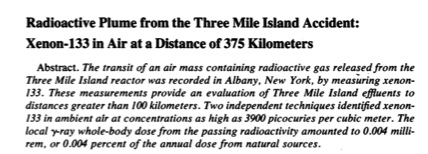• • •
"Mike and Jon, Jon and Mike—I've known them both for years, and, clearly, one of them is very funny. As for the other: truly one of the great hangers-on of our time."—Steve Bodow, head writer, The Daily Show
•
"Who can really judge what's funny? If humor is a subjective medium, then can there be something that is really and truly hilarious? Me. This book."—Daniel Handler, author, Adverbs, and personal representative of Lemony Snicket
•
"The good news: I thought Our Kampf was consistently hilarious. The bad news: I’m the guy who wrote Monkeybone."—Sam Hamm, screenwriter, Batman, Batman Returns, and Homecoming
April 05, 2011
Science to the Rescue
By: Aaron Datesman
There is an interesting story on the Three Mile Island Alert web site which I’ve so far neglected to mention. It surprised me a lot when I first read it: I thought (yet again!), how can it be I’ve never heard this? Charles Armentrout was a physics professor in Portland, Maine, when he detected radiation from fallout from the accident in April, 1979.
Thirty years ago, April 1, 1979, on the rooftop of a building at the University of Southern Maine in Portland, a nuclear radiation recording device went from being relatively quiescent to rapidly recording extremely high levels of beta radiation, 100 times the normal background levels.The equipment had been set up by USM physics professor Charles Armentrout a few days earlier as a teaching project for his students to see if any fission products from the Three Mile Island power plant accident could be detected in Maine. It was a rainy Sunday, five days after the partial meltdown at the power plant just southeast of Harrisburg, Pennsylvania.
In Portland the wind had been from the southwest and then shifted to come in off the ocean. It was then that the professor's pulse frequency counter began to go crazy. A second counter brought to the roof did the same thing, so Armentrout knew his readings were real. This was equipment that had required him to obtain federal and state licences to operate and which he was also required to have periodically calibrated at the state's radiology lab in Augusta.
The article goes on to describe government denials and contradictory claims involving nearby monitoring stations and claims about radon, all of which leave the lay reader without an intelligent basis upon which to form an opinion. On my first couple of readings, however, somehow I missed the most interesting piece of the article: corroborating evidence from Albany, NY, was published in Science magazine less than a year later. Naturally, I went ahead and looked up the article:

Science magazine is an esteemed scientific journal. It’s a very big deal to have an article published there. I should add that Science magazine is also to the scientific community sort of what the Washington Post is to a certain variety of Serious People: it’s the repository of accepted beliefs. I’m still shocked to discover that this article made it through review and was published there.
On the other hand, it may be that the totally benign health estimate of 0.004 millirems whole body dose in the abstract had something to do with the publication decision. In that vein, you should take a moment and examine the last sentence in the abstract again. Go ahead, do it. It won’t hurt you.
Do you see? That’s the gamma ray dose. Xe-133 is a beta emitter – which the authors knew very well, since their article described measurements they made of the beta decay spectrum. The benign dose estimate the article gives is based upon assumptions which throw away nearly all of the negative effects. It’s somewhat noteworthy that the relevant reference in the article - which I imagine the authors cite because they used it as a guide for determining the health effects due to exposure – is a document from the U.S. Atomic Regulatory Commission entitled Regulatory Guide 1.4: Assumptions Used for Evaluating the Potential Radiological Consequences of a Loss of Coolant Accident for Pressurized Water Reactors.
Despite that rather questionable health physics calculation, the article includes a lot of really fascinating information, including good information about the weather conditions and atmospheric transport from the days following the accident. I think this piece is interesting:
For the first release period on 28 March, the meteorological conditions at Middletown were rather stagnant, with medium- to low-speed winds gradually shifting from northwesterly to north-easterly to easterly and finally to south-easterly.
It occurs to me that a slow northeasterly wind would blow from TMI in the direction of the Holowka farm in Zion’s View.
Although they found very high concentrations (3900 pCi/m^3) of Xe-133, the authors did not find high levels of two other radioisotopes for which they were looking: I-131 and Kr-85. I think this is interesting in light of some of the TMI release estimates which Arnie Gunderson has put forward, but that’s a topic for another post.
The thing about the article which I find most alarming, however, is the information it rather blithely contains about “routine releases from nuclear reactors”:
In 1974 the concentration of Xe-133 from all sources including routine releases from nuclear reactors was 2.6 pCi/m^3 for the Albany area.
The Kr-85 measured … within the range of 10.9 to 18.4 pCi/m^3 encountered in samples of Albany air for the period 1975 to 1979.
Frankly, when I first began to learn about this topic in 2009, it was news to me that there are such things as “routine releases” from nuclear reactors resulting in measurable levels of radioactivity in the local environment. But, there it is – in Science magazine.
Lastly, I would like to share a final note about geography. First, from the Science article:
The mean transport layer forward trajectories for this period passed 80 to 160 km south of Albany.
Second, from the TMIA article about Prof. Armentrout in Portland:
In Portland the wind had been from the southwest and then shifted to come in off the ocean.
On the map below, I have drawn a line from the location of Three Mile Island to a point 120km south of Albany, NY. (The line is a guide for the eye, not an indication of where fallout landed or did not. There was a very high level of radiation measured in Albany, which is around 100km away from any point on the line. Envision a cloud centered on the line instead.) You can see that the line ends up over the Atlantic Ocean east of Portland, ME.
It also rolls almost right across my childhood home in Lehigh County (Allentown/Bethlehem, PA).

— Aaron Datesman
Aaron,
In a previous post, you mentioned that low doses of radioactivity may actually be better than higher doses to a certain point because the cells are more likely to be wounded just enough not to die and to mutate into cancer.
I have a potentially really dumb question, with exposures to small doses of radiation, do you think it is possible that getting radiated with a chemotherapy type of blast could decrease your chances of developing cancer? Obviously, that would be awful to go through, but I wonder if these are the kinds of questions that follow from what you are saying.
Posted by: Justin at April 5, 2011 09:33 PMBechtel Leakers=peroidic releases=burping the kettel.
Posted by: Mike Meyer at April 5, 2011 10:14 PMAaron
Very interesting, and I continue to be impressed by how much I don't understand while still being able to more or less follow along (which shows good writing), but I hope you haven't forgotten about the ozone.
Posted by: N E at April 6, 2011 09:39 AMJustin - the point I made in the earlier post (which got sufficient attention that I think the whole point of what I wrote was obscured) relates to biological action at the level of a single cell. The human organism is TREMENDOUSLY complicated. Not only don't I know the answer to your question, I don't think the answer can be known.
This was settled out in the comments in the last post but, to be clear, the point I was making is that the underlined sentence in the BEIR report is wrong. There IS reason to suspect that the biological outcomes for individual cells are not linear in the manner described. Chapter II of the BEIR report actually mentions a few of them in passing, in addition to the thought about triggers for apoptosis which I described.
Therefore I believe that we should really examine the effects that low, sustained doses have at the level of entire organisms. The confident pronouncements we hear make it seem as though this science has been done and is a settled matter. It has never been conducted and is not.
Posted by: Aaron Datesman at April 6, 2011 11:16 AMThis blog has become unreadable in the last few months. I'm done.
Posted by: DS at April 6, 2011 01:24 PMSo there, I guess.
Posted by: N E at April 6, 2011 01:47 PMbuh-bye.
Posted by: cruel world at April 6, 2011 01:51 PMActually, I spent five hours Monday night reading charts of mortality statistics from the National Vital Statistics Survey. Lately, that's the sort of thing I do for FUN! I think I'm with DS on this one.....
Posted by: Aaron Datesman at April 6, 2011 02:26 PMAaron
It gets worse.
Posted by: N E at April 6, 2011 02:53 PMQ:
They're measuring levels, but are they actually saying that the "routine releases" are responsible for certain measured changes?
Posted by: Earwig at April 6, 2011 03:58 PMAaron,
About two seconds after I posted the comment, it occurred to me I should have read the other comment thread first. Thanks for answering.
I have to STRONGLY disagree with DS. JS's sense of humor is invaluable, but the discussion you are leading here about the dangerous quantity that is nuclear power is very important. Look at your posts about 3 Mile Island, what you are pulling at is a benign cover that has hidden the dangers of nuclear power.
The explanations you are coming with are also pretty great information, such as the cold air hot air klines and how they occur.
Posted by: Justin at April 6, 2011 04:44 PMNo, no! Please, more.
Posted by: Amandasaurus at April 6, 2011 11:21 PMI was wondering if you were planning on blogging about yellow rain during this Japan issue. I've seen some stuff about it from people, and these two articles:
http://www.reuters.com/article/2011/04/07/us-japan-quake-korea-idUSTRE7360KL20110407
http://www.globalresearch.ca/index.php?aid=23959&context=va
Reading your post on blue light, I thought you might be able to explain this phenomenon.
Posted by: Nathanael Bassett at April 7, 2011 09:50 AMEarwig, if you mean the routine releases, all the EPA scientists (the authors of the Science paper were with EPA) said is that - if TMI did release radioactive I and Kr - it had to be below the background level in Albany. They made no statement relating to health effects, although there was a clear statement in the article that nuclear reactor emissions contributed to the measured levels.
Posted by: Aaron Datesman at April 7, 2011 01:36 PMOh! Edit: the authors were with the NY State Dept. of Health. Oops.
Posted by: Aaron Datesman at April 7, 2011 06:03 PMThanks for that clarification, Aaron.
Posted by: Earwig at April 11, 2011 07:38 PM


